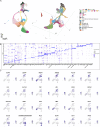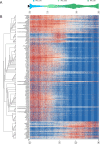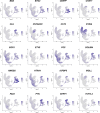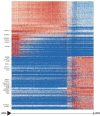Temporal transcriptomic dynamics in developing macaque neocortex
- PMID: 38415809
- PMCID: PMC10911584
- DOI: 10.7554/eLife.90325
Temporal transcriptomic dynamics in developing macaque neocortex
Abstract
Despite intense research on mice, the transcriptional regulation of neocortical neurogenesis remains limited in humans and non-human primates. Cortical development in rhesus macaque is known to recapitulate multiple facets of cortical development in humans, including the complex composition of neural stem cells and the thicker supragranular layer. To characterize temporal shifts in transcriptomic programming responsible for differentiation from stem cells to neurons, we sampled parietal lobes of rhesus macaque at E40, E50, E70, E80, and E90, spanning the full period of prenatal neurogenesis. Single-cell RNA sequencing produced a transcriptomic atlas of developing parietal lobe in rhesus macaque neocortex. Identification of distinct cell types and neural stem cells emerging in different developmental stages revealed a terminally bifurcating trajectory from stem cells to neurons. Notably, deep-layer neurons appear in the early stages of neurogenesis, while upper-layer neurons appear later. While these different lineages show overlap in their differentiation program, cell fates are determined post-mitotically. Trajectories analysis from ventricular radial glia (vRGs) to outer radial glia (oRGs) revealed dynamic gene expression profiles and identified differential activation of BMP, FGF, and WNT signaling pathways between vRGs and oRGs. These results provide a comprehensive overview of the temporal patterns of gene expression leading to different fates of radial glial progenitors during neocortex layer formation.
Keywords: developmental biology; macaque cortex; neural progenitor; neuroscience; prenatal neurogenesis; rhesus macaque; scRNA-seq.
© 2023, Xu, Yuan, Zhou et al.
Conflict of interest statement
LX, ZY, JZ, YZ, WL, SL, ZH, BQ, PS, YC, XP No competing interests declared
Figures





















Update of
- doi: 10.1101/2023.07.13.548828
- doi: 10.7554/eLife.90325.1
- doi: 10.7554/eLife.90325.2
Similar articles
-
Comparative analysis of the subventricular zone in rat, ferret and macaque: evidence for an outer subventricular zone in rodents.PLoS One. 2012;7(1):e30178. doi: 10.1371/journal.pone.0030178. Epub 2012 Jan 17. PLoS One. 2012. PMID: 22272298 Free PMC article.
-
Pax6 mediates ß-catenin signaling for self-renewal and neurogenesis by neocortical radial glial stem cells.Stem Cells. 2014 Jan;32(1):45-58. doi: 10.1002/stem.1561. Stem Cells. 2014. PMID: 24115331 Free PMC article.
-
Zbed3 Is Indispensable for Wnt Signaling Regulation of Cortical Layers Formation in Developing Brain.Cereb Cortex. 2021 Jul 29;31(9):4078-4091. doi: 10.1093/cercor/bhab070. Cereb Cortex. 2021. PMID: 33822906
-
Neural progenitors, neurogenesis and the evolution of the neocortex.Development. 2014 Jun;141(11):2182-94. doi: 10.1242/dev.090571. Development. 2014. PMID: 24866113 Review.
-
Decoding mixed messages in the developing cortex: translational regulation of neural progenitor fate.Curr Opin Neurobiol. 2021 Feb;66:93-102. doi: 10.1016/j.conb.2020.10.001. Epub 2020 Oct 23. Curr Opin Neurobiol. 2021. PMID: 33130411 Free PMC article. Review.
Cited by
-
Reconstructing human-specific regulatory functions in model systems.Curr Opin Genet Dev. 2024 Dec;89:102259. doi: 10.1016/j.gde.2024.102259. Epub 2024 Sep 12. Curr Opin Genet Dev. 2024. PMID: 39270593 Review.
References
-
- Bakken TE, Miller JA, Ding S-L, Sunkin SM, Smith KA, Ng L, Szafer A, Dalley RA, Royall JJ, Lemon T, Shapouri S, Aiona K, Arnold J, Bennett JL, Bertagnolli D, Bickley K, Boe A, Brouner K, Butler S, Byrnes E, Caldejon S, Carey A, Cate S, Chapin M, Chen J, Dee N, Desta T, Dolbeare TA, Dotson N, Ebbert A, Fulfs E, Gee G, Gilbert TL, Goldy J, Gourley L, Gregor B, Gu G, Hall J, Haradon Z, Haynor DR, Hejazinia N, Hoerder-Suabedissen A, Howard R, Jochim J, Kinnunen M, Kriedberg A, Kuan CL, Lau C, Lee C-K, Lee F, Luong L, Mastan N, May R, Melchor J, Mosqueda N, Mott E, Ngo K, Nyhus J, Oldre A, Olson E, Parente J, Parker PD, Parry S, Pendergraft J, Potekhina L, Reding M, Riley ZL, Roberts T, Rogers B, Roll K, Rosen D, Sandman D, Sarreal M, Shapovalova N, Shi S, Sjoquist N, Sodt AJ, Townsend R, Velasquez L, Wagley U, Wakeman WB, White C, Bennett C, Wu J, Young R, Youngstrom BL, Wohnoutka P, Gibbs RA, Rogers J, Hohmann JG, Hawrylycz MJ, Hevner RF, Molnár Z, Phillips JW, Dang C, Jones AR, Amaral DG, Bernard A, Lein ES. A comprehensive transcriptional map of primate brain development. Nature. 2016;535:367–375. doi: 10.1038/nature18637. - DOI - PMC - PubMed
-
- Bernard A, Lubbers LS, Tanis KQ, Luo R, Podtelezhnikov AA, Finney EM, McWhorter MME, Serikawa K, Lemon T, Morgan R, Copeland C, Smith K, Cullen V, Davis-Turak J, Lee C-K, Sunkin SM, Loboda AP, Levine DM, Stone DJ, Hawrylycz MJ, Roberts CJ, Jones AR, Geschwind DH, Lein ES. Transcriptional architecture of the primate neocortex. Neuron. 2012;73:1083–1099. doi: 10.1016/j.neuron.2012.03.002. - DOI - PMC - PubMed
-
- Betizeau M, Cortay V, Patti D, Pfister S, Gautier E, Bellemin-Ménard A, Afanassieff M, Huissoud C, Douglas RJ, Kennedy H, Dehay C. Precursor diversity and complexity of lineage relationships in the outer subventricular zone of the primate. Neuron. 2013;80:442–457. doi: 10.1016/j.neuron.2013.09.032. - DOI - PubMed
Publication types
MeSH terms
Grants and funding
LinkOut - more resources
Full Text Sources

